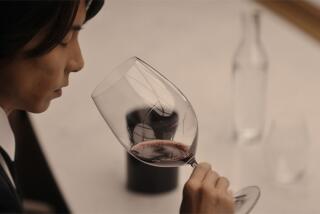IN THE KITCHEN : Flavored Vinegars: Setting Up Shoppe
In the beginning there was raspberry vinegar, and it was good . . . well, pretty good, when used in the right way. But before long, raspberry vinegar begat other vinegar trends in the American kitchen: fruit vinegars, which begat herbal vinegars, which begat, most recently, balsamic vinegars.
There is nothing intrinsically wrong with any of these. In fact, even raspberry vinegar--the kiwi fruit of spoiled wine--is good in its place. It’s just that that place is not every place.
Along with the proliferation of flavored vinegars came a rapid escalation in price. And along with the price explosion came a tidal wave of cute packaging. Vinegars, it sometimes seems, have become the scented potpourri of the food world--showing up at every “shoppe” that peddles pricey edibles. Granted, they’re not as worthless as flavored coffees, but in their own sweet way they are just as aggravating.
The worst part about this whole gushy nonsense is the ridiculous ease--to say nothing of economy--of making flavored vinegars yourself. If you have plain old distilled white vinegar (the kind you may use now for washing windows), fresh herbs, fruits or vegetables to flavor it and a mayonnaise jar, you have everything you need.
Decide on the flavorings and put an ample amount in the mayonnaise jar. Pour vinegar over to cover. Shake to mix well. Let stand for, oh, a month or two, then strain the vinegar through cheesecloth into the bottle in which you plan to store the vinegar. You can add a few more sprigs of herbs, if you like, to make it pretty. If you’re in a hurry, you can cut the time to a couple of weeks by bringing the vinegar to a boil before adding it to the flavorings.
*
Measures can be loose and combinations can be whimsical--one herb-growing friend made a vinegar with sweet cicely and five basils, reminding me more of a P. G. Wodehouse story than a flavoring. Take your time waiting for the flavors to infuse. You’ll know when it’s done because it will taste done.
As with anything else this simple, there are those who will try to complicate matters by telling you things can only be done a certain (usually more expensive) way. For example, I have a book in front of me in which the author insists she only uses the best Champagne vinegar in her flavored vinegars because it’s less acidic.
Well, I say to her: Check the label. Almost all vinegars have roughly the same acidity--5%. The exceptions are rice wine vinegar, which is 4% (its noticeable sweetness does well with some flavorings, but with most it is just too much), and balsamic, which is 6% (far too aggressive to play well with others). Besides, if you have a truly good, delicate Champagne vinegar, why muck it up with other flavorings? It’s like making coq au vin with great red Burgundy.
Another thing: Check the fine print on the labels of many of the expensive flavored vinegars and you’ll find they’re made with--and I’m quoting here--”A blend of distilled vinegar, malt vinegar and spice oil.”
To decide on which flavorings to add to the vinegar, follow your nose. Since the punchy taste of vinegar is so overpowering, it’s the smell that relays the relatively subtle flavorings. Think about things that smell good, or that smell good together. Keep a cool head, especially at first--after a few experiments you’ll find the combinations that work for you.
There are some classics that seem to recur frequently--tarragon, or rosemary and garlic, for example--but you shouldn’t feel limited to herbs. You can make a dandy raspberry vinegar by steeping mushed-up frozen raspberries in white distilled vinegar. Of course, after you strain it, you’ll probably want to plop in a couple whole fresh berries for looks. I also really like pear vinegar.
Think about vegetables too. Red bell peppers and even whole onions make great flavored vinegars.
*
When you’re picking the fruits or vegetables, there’s no need to buy the prettiest, since they’ll be thrown out before the final bottling. What is necessary is absolute ripeness--with the strong taste of vinegar, you need as much flavoring as you can get.
After the aging, you could keep your vinegars in the mayonnaise jars in which they were made (functional, but not exactly something you want the world to see), but most cookware catalogues sell nice-looking empty bottles for home vinegar makers. I use old wine bottles. I get a perverse kick out of pouring vinegar from a bottle labeled “Grand Vin de Chateau Latour.” Here’s a hint: R.H. Phillips winery makes a decent Rhone-like blend called “Night Harvest Cuvee Rouge” that comes in really elegant 500-milliliter bottles. It’s also commonly available at about $4 a bottle--less than what you might pay for the container without the wine if purchased from a cookware catalogue.
So, once you’ve made all these vinegars, what in the heck do you do with them? The easy answer, of course, is to use them in salad dressings. Personally, though, unless the salad is something elaborate, I prefer lemon juice.
Instead, I like to use these vinegars in prepared foods. Use them to marinate meat or fish before you put them on the grill. Or use them to deglaze saute pans to make quick sauces: Remove the cooked food, add a couple tablespoons of vinegar and boil hard, scraping the bottom of the pan to get up any browned bits that stuck; then taste and add a little water if the flavor is too sharp; now throw in a couple pats of butter and swirl until it incorporates.
Or maybe you could just put up chintz curtains and a plaque: “Ye Olde Vinegar Shoppe.”
caption
More to Read
Eat your way across L.A.
Get our weekly Tasting Notes newsletter for reviews, news and more.
You may occasionally receive promotional content from the Los Angeles Times.











